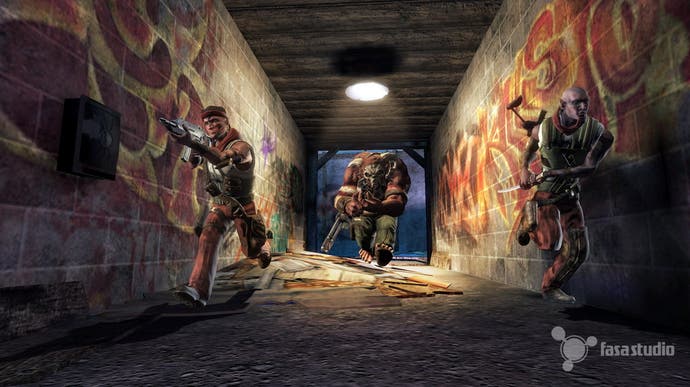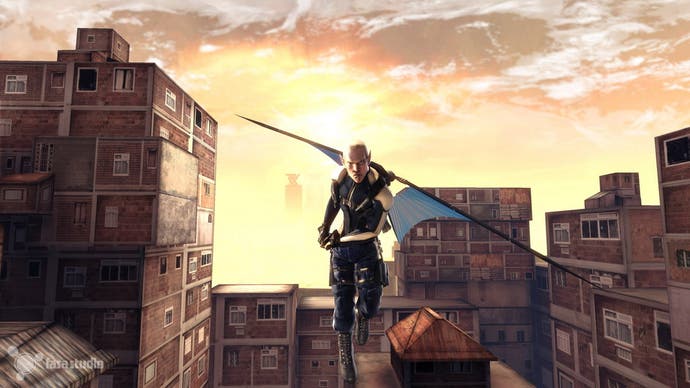Shadowrun
Cross-platform online gaming starring Elves, Dwarves and Trolls.
Since Microsoft announced plans to create a third videogame based on the pen and paper RPG Shadowrun, the fans have made their disappointment clear.
See, Microsoft's FASA Interactive will not be transforming it into an open-ended, epic videogame RPG that you might expect - something along the lines of a cyberpunk Elder Scrolls or a fantasy-tinged Deus Ex, for example. Nope, instead the company will be taking the nuanced blend of fantasy and dystopian sci-fi that has evolved over 18 years of pen and paper gaming into one of the most rich and complex of RPG settings, and it will be creating an online-only arena-based first-person shooter. But who cares about the fans if the online-only arena-based first-person shooter in question turns out to be brilliant?
But does it look like it's going to be brilliant? Well it looks like it could be a brilliant advert for cross-platform gaming over Xbox Live. Microsoft has been making a bit of a song and dance about the fact that Shadowrun is one of the first games that will allow PC gamers to take on Xbox 360 gamers over Xbox Live. Which, if you think about it, is a pretty reasonable idea. It's just it's probably going to be one of those reasonable ideas that people very quickly take for granted, without ever giving any credit to the people who came up with the idea. Because, to judge from a recent demonstration of Shadowrun, Live on Windows Vista is indistinguishable from Live on Xbox 360.

"You can voicechat, you can create a Friends list, and you can do game invites just like on the console," explains FASA's studio manager, Mitch Gitelman. "If you're already a member of Xbox Live, your stuff works on Games for Windows Live, too. You use the same gamertag, and can show off the same gamerscore and achievements on each platform. The rest of the Xbox Live features, like Marketplace are coming later." More importantly, it was impossible to tell whether people were playing with a controller or via keyboard and mouse.
"There's a number of different ways that we've balanced it," continues Gitelman. "For one thing we have an accuracy model sort of like Counter-Strike in a way: what happens is as you fire your weapon you become more and more inaccurate, so you have to use short, controlled bursts. So we played around with that, and we played around with the aim assistance on the controller. What we found when we first started was that the controller people were absolutely owning the mouse and keyboard people, without a doubt. So we had to make some adjustments - there's things like smoothing and all that sort of stuff." There's also the fact that Shadowrun isn't just about crackshot crosshair accuracy, but more on that later.
For now, what about Shadowrun itself? Well it's set in Brazil in the year 2031, so it depicts events 25 years before the pen and paper game, and it depicts a conflict between RNA Global (a megacorporation), and The Lineage (a 5,000 year old secret society) for control of a magic artefact. And it's an online-only arena-based first-person shooter. The action takes place between two teams of eight players, over a series of four-minute rounds, with the action falling into one of three modes: Raid (one team tries to capture the artefact; the other team tries to stop them); Extraction (both teams try to capture the artefact); and Attrition (both teams try to kill each other). Players carry two weapons from a fairly conventional selection (eg. pistol, shotgun, grenades, sniper rifle), and during the first 30 seconds of each round players can spend money earned in combat on equipping themselves. So far, so conventional.

So what distinguishes it from every single other online-only arena-based first-person shooter out there? Well, principally, the fact that players can supplement their pistols and shotguns with magic abilities and cybernetic enhancements. Or, as Gitelman puts it: "I can use magic to teleport through walls, through the floor, through the ceiling, through enemies. I can also glide, using a glider backpack - so I can glide over the battlefield. But the interesting thing about Shadowrun is the way that you can combine these interesting abilities together to outsmart the enemy. So for example I could jump off a building, start to glide, and just before I hit the wall to the next building, teleport right rhough that wall."
"There's other abilities in the game too. I could use my cybernetic vision to look through a wall. I might see a troll on the other side of the wall. So I teleport through with my katana, take him out from behind and then when an army of dwarves come to get me I can teleport back up through the ceiling, glide across the battlefield to a sniper perch, pull up my sniper rifle, use my vision again. And then when I see somebody about to poke his head out I snipe him, and then when everybody swarms all over me I turn into a puff into smoke and the bullets go right through me and they hit each other. You can see how that can really change the way first person shooters are played."
So what distinguishes it from every single other online-only arena-based first-person shooter out there is that it features a whole load of innovative abilities and equipment, each of which can be used in innovative ways or combinations to create open-ended tactical variation. Take, for example, the Tree of Life. There are no medpacks in the game, but you can use magic to create a permanent Tree of Life, which heals anybody nearby - including enemies. And, of course, since it's permanent, you can also use it for cover. Another power, called Strangle, allows players to create crystal blockades - sealing up walls, or creating a defensive barrier in the middle of battle - or even, by casting it directly at an opponent, incapacitating enemies, making them a sitting target.

Tech abilities include wired reflexes, which allow you to run faster, reload faster and jump faster; enhanced vision, which allow you to see further, and through walls; and a glider, which allows you to, um, glide. And although you're free to choose from both magic and tech, each piece of tech reduces the amount of Essence available to use magic; and while Essence eventually recharges, some spells place a permanent drain on your resources, and some tech items can suck all the Essence out of their surrounding area.
The other thing that distinguishes the game is that you can choose from four different races: Elves are fast but flimsy but they regenerate so they're good for hit and run tactics. Dwarves suck magic out of the area, preventing other characters from using their magic skills, and they're immune to headshots. And, of course, they're short, making them smaller targets. Trolls are slow, but they become more resistant to damage the more they take, and they're also the strongest race. And humans are, obviously, the all rounder.
With all those possibilities on offer, the game itself does have a bit of a learning curve. There are six training chapters to prepare players, but initially it can be confusing as you try to remember what ability you've mapped to which of the three buttons that are available. That's probably why your humble correspondent spent most of the hands-on part of the demonstration humbled and hands-off, staring at a dead carcass on the screen (like Counter-Strike, if you die you remain a mere spectator until the next round. Unless your team-mate uses magic to resurrect you. Unless your opponent has used damage to destroy your body, in which case you can't be resurrected).

Still, in the brief moments before getting shot, it's pretty clear that using the various abilities in combination can open up an abundance of tactical avenues. Using enhanced vision, teleport and glide in conjunction to conduct hit and run attacks all over the map is pretty satisfying stuff, but the real possibilities became apparent after sitting back and watching some of the FASA experts at work. In experienced hands the combination of magic and tech opens up a dizzying range of tactical possibilities - a sort of moving Magic: the Gathering, if you will. It was particularly instructive to watch the experts gliding high above the action to survey the earthbound pack of journalists, utilising the huge vertical scope of some of the maps.
The game does have a singleplayer of sorts: it's possible to play entirely with or against bots in any combination. But after seeing the polished and strategically complex combat it's difficult not to feel some slight disappointment that it's not been wrapped up in a singleplayer campaign that does justice to the game setting. Nevertheless, Shadowrun is undeniably a pretty decent online-only arena-based first-person shooter, and although the hands-on experience was fairly harsh, it's the kind of game that will reward repeated play, especially with regular team-mates, with whom you can establish specialised roles and tactics.


.png?width=291&height=164&fit=crop&quality=80&format=jpg&auto=webp)




.jpg?width=291&height=164&fit=crop&quality=80&format=jpg&auto=webp)
